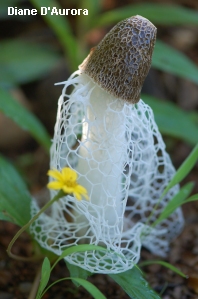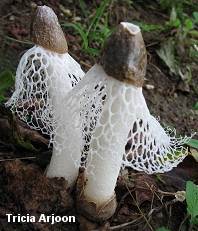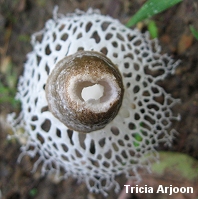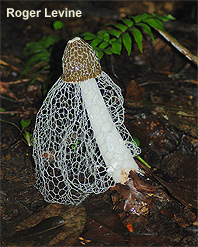| Major Groups > Stinkhorns > Phallus indusiatus |

|
Phallus indusiatus [ Basidiomycota > Agaricomycetes > Phallales > Phallaceae > Phallus . . . ] by Michael Kuo This amazing pan-tropical stinkhorn features a long and elaborate "skirt." In North America, it is found in the southern provinces of Mexico; northward it is replaced by the short-skirted Phallus duplicatus. Readers who have seen the Discovery Channel's Planet Earth series may remember the stunning time-lapse photography sequences of Phallus indusiatus rising from the ground, then gracefully extending its net-like skirt. Strictly speaking, Phallus indusiatus should be a fairly large species featuring an ample, white skirt that stretches nearly to the ground, descending from a bell-shaped cap that is pocketed and white (underneath the brown spore slime), along with a smooth, pinkish to whitish volva. The species was originally described from Suriname (Ventenat 1798) and a neotype collection has been designated from Brazil (Cabral et al. 2019). However, many very similar species exist:
. . . and the list above is not exhaustive! Meanwhile there are similar species with colored skirts and/or colored caps, including Phallus cinnabarinus (with a red to orange skirt) and Phallus multicolor (with a somewhat shortened, yellow skirt), Phallus luteus (short yellow skirt, orange cap, brown volva), and Phallus flavidus (small with cap, stem, and skirt yellow to orange). Have you collected indusiatus-like species of Phallus specimens recently? I would love to study well-documented, preserved collections, in order to make this page more scientific. If you're interested in helping, please send me an email at . Dictyophora indusiata is a synonym. Description: Note: The description below is based on the photos sent to me, and on the sources cited below. I have not studied any collections of Phallus indusiatus. Ecology: Saprobic; growing alone or gregariously in woods, especially in disturbed-ground areas (ditches, paths, road sides, and so on); also common in urban settings; year-round; originally described from Suriname; distributed in South America, Central America, and Mexico; also reported throughout the tropics, nearly world-wide. Immature Fruiting Body: Like a whitish, brownish, or pinkish "egg"; when sliced revealing the stinkhorn-to-be encased in a gelatinous substance. Mature Fruiting Body: Cylindric, with a clearly differentiated head structure that sits atop the stem; developing a net-like structure that extends below the head. Head: Up to about 4 cm high and 4 cm wide; broadly conic or bell-shaped; becoming perforated at the apex, with the perforation surrounded by a sterile whitish "lip"; becoming deeply pitted and pocketed in a reticulate pattern; surface white to creamy, but covered with a thick layer of dark brown spore slime. Indusium (the "net"): Developing below the bottom rim of the head; eventually extending to the ground and flaring away from the stem; white, sometimes becoming pinkish with old age; with thin dissepiments. Stem: Up to 20 cm high and 2 cm thick; cylindric; finely pocketed; whitish; hollow; base enclosed in a whitish to pinkish volva; attached to white or pinkish rhizomorphs. Odor: Unpleasant and strong. Microscopic Features: Spores 3.5–4 x 1.5–2 µm; elongated-ellipsoid; smooth; hyaline in KOH. Sphaerocysts of the pseudostipe 30–60 µm; subglobose; smooth; hyaline in KOH. Hyphae of the volva 3–7 µm wide; smooth; yellowish; clamp connections present. REFERENCES: E. P. Ventenat, 1798. (Persoon, 1801; Lloyd, 1909; Cunningham, 1944/1979; Dring, 1964; Arora, 1986; Guzmán, Montoya & Bandala, 1990; Calonge, 2005; Calonge et al., 2005; Kreisel & Hausknecht, 2009; Gogoi & Parkash, 2014; Li et al., 2016; Trierveiler-Pereira et al., 2017; Cabral et al., 2019.) This site contains no information about the edibility or toxicity of mushrooms. |
© MushroomExpert.Com |
|
Cite this page as: Kuo, M. (2022, March). Phallus indusiatus. Retrieved from the MushroomExpert.Com Web site: http://www.mushroomexpert.com/phallus_indusiatus.html |



